Abrskil or Abrskila was the hero of Abkhazian national epos, Abrskil. He was a role model of the Greek Prometheus and hence was also known as Abkhaz Prometheus. The Abrskil Cave, a notable landmark near the village of Otapi, is named after this legend. [1] [2]
According to the popular folk legend of Abkhazian, Abraskil is the name of the legendary boy born out of wedlock to a lovely girl called Abkhazia. He grew up in wild and wayward ways. He was unlike other boys and grew up into a very strong, handsome person with huge ambitions. He could ride on a horse and hurl large stones while riding on it. His favourite horse was called Arasch. His bravery and daring was a kind of Robin Hood image for his friends and compatriots. He challenged God that he was as good as Him and that he could perform any act which God could do. He moved between the mountains and the sea with great aplomb and abandon; he was kind of invincible in his movements on his magic horse Arasch. He had a following of compatriots.
However, God told Abrskil to give up his cruel killing of people and destruction of forest land. He was asked to submit himself before God for punishment. Since Abrskil was very proud and brave he refused and God became furious and directed His angels to capture Abrskil as prisoner to mete out suitable punishment. The apostles of God, called as afehambres, were appointed by God to catch Abraskil. Abraskil used a handy tool called alabasha (a kind of bludgeon) to negotiate from place to place between the mountain and the sea, performing a Tarzan act that made it difficult for the apostles or angels to catch him.
The apostles then hatched a plan to catch him by spreading slippery cow skins near the sea. As Abraskil jumped with his horse Arasch from the mountain to the sea shore, his horse slipped and he fell and was hurt. He was immediately caught by the angels. He made every effort to escape but woodpeckers' help was sought to break his alabasha to prevent him from escaping. As he fell from his horse towards the shores of the Black Sea, his alabasha also broke and he was caught within the cow skin near the sea. He could not escape.
He was then tied up and brought to a cave in a nearby hill, close to the Otap village. There, he was chained to a pillar in the cave and his horse was also tied to a nearby post. For seven days and nights he tried in vain to break loose from the post. As he was making these efforts to get free, a bird (boloqanqara) sat on the pillar. Abraskil was furious and he struck at the bird with the hammer. As his bad luck would have it, the hammer got firmly stuck in the pillar and the bird flew away. He and his horse could not escape. He was imprisoned in the cave. The cave where he and his horse were tied up is now famous and is called the achuats tizgo ("place of horse’s dung"). While his friends, particularly Djmlot, tried to get him freed, the fair-skinned, blue-eyed people of the village exulted at his plight in the cave. He could not escape from the cave. [3] [4]
According to ancient historical records, it has been inferred that Abrasil, the folk hero of Abkhazian, was known to the ancient Greeks as well. A parallel has therefore been drawn between the Greek folk mythical hero, Promethesus, and that of Abrasil. [5]
In ancient times, the Greeks had founded the Black Sea colonies. They were fully aware of the warriors of the coastal regions of the Black Sea who acted like pirates in the region. These people were identified as the Heniochis. This class of people were the ancestors of the present-day Abkhazians. The folk hero of Abkhazians was thus known to the Greeks and they in turn created their own folk hero and called him Promethesus. Their folk hero was also punished by gods for bringing “fire to humanity”. The difference in the folk legend is that Promethesus was tied to the mountains and subjected to torture by attack by eagles. [5]
A notable landmark connected with the legend of the folk hero is the Abrskil Cave (or "Abrskila") located near the village of Otap. The cave is named after the hero of Abkhazian national epos, Abrskil, where he was imprisoned. This karst cave reaches a length of about 2 km (3 km in some references) although only 1,500–1,700 meters are accessible to tourists. [6] The part of the cave which is open to tourists consists of several chambers studded with stalactites, and stalagmites.

Vladislav Ardzinba was the first de facto President of Abkhazia. A historian by education, Ardzinba led Abkhazia to de facto independence in the 1992–1993 War with Georgia, but its de jure independence from Georgia remained internationally unrecognised during Ardzinba's two terms as President from 1994 to 2005.

Sergei Uasyl-ipa Bagapsh was an Abkhaz politician who served as the second President of Abkhazia from 12 February 2005 until his death on 29 May 2011. He previously served as Prime Minister of Abkhazia from 1997 to 1999. He was re-elected in the 2009 presidential election. Bagapsh's term as Prime Minister included the 1998 war with Georgia, while he oversaw both the recognition of Abkhazia by Russia and the Russo-Georgian War during his presidency.

The Abkhazians or Abkhazes are a Northwest Caucasian ethnic group, mainly living in Abkhazia, a disputed region on the northeastern coast of the Black Sea. A large Abkhaz diaspora population resides in Turkey, the origins of which lie in the population movements from the Caucasus in the late 19th century. Many Abkhaz also live in other parts of the former Soviet Union, particularly in Russia and Ukraine.

Aleksandr Zolotinskovich Ankvab is an Abkhaz politician and businessman who was president of Abkhazia from 29 May 2011, until his resignation on 1 June 2014. Under president Sergei Bagapsh, he previously served as prime minister from 2005 to 2010 and vice-president from 2010 to 2011. He was appointed prime minister again on 23 April 2020.

The Kingdom of Abkhazia, also known Egrisi-Abkhazia, was a medieval feudal state in the Caucasus which was established in the 780s. Through dynastic succession, it was united in 1008 with the Kingdom of the Iberians, forming the Kingdom of Georgia.
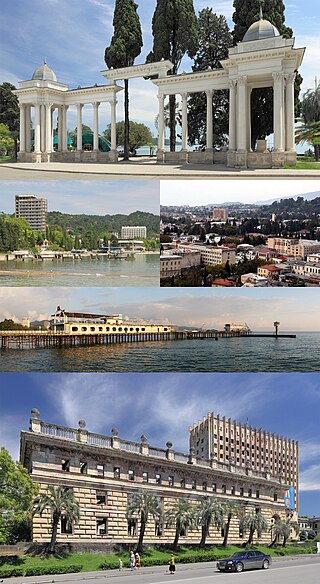
Sukhumi is a city in a wide bay on the Black Sea's eastern coast. It is both the capital and largest city of the Republic of Abkhazia, a partially recognised state widely recognized as a part of Georgia. The city has been controlled by Abkhazia since the Abkhazian war in 1992–93. The city, which has an airport, is a port, major rail junction and a holiday resort because of its beaches, sanatoriums, mineral-water spas and semitropical climate. It is also a member of the International Black Sea Club.

New Athos or Akhali Atoni is a town in the Gudauta raion of Abkhazia situated some 22 km (14 mi) from Sukhumi by the shores of the Black Sea. The town was previously known under the names Nikopol, Acheisos, Anakopia, Nikopia, Nikofia, Nikopsis, Absara, and Psyrtskha.

The history of Abkhazia, a region in the South Caucasus, spans more than 5,000 years from its settlement by the lower-paleolithic hunter-gatherers to its present status as a partially recognized state.

Nestor Apollonovich Lakoba was an Abkhaz communist leader. Lakoba helped establish Bolshevik power in Abkhazia in the aftermath of the Russian Revolution, and served as the head of Abkhazia after its conquest by the Bolshevik Red Army in 1921. While in power, Lakoba saw that Abkhazia was initially given autonomy within the USSR as the Socialist Soviet Republic of Abkhazia. Though nominally a part of the Georgian Soviet Socialist Republic with a special status of "union republic," the Abkhaz SSR was effectively a separate republic, made possible by Lakoba's close relationship with Joseph Stalin. Lakoba successfully opposed the extension of collectivization of Abkhazia, though in return Lakoba was forced to accept a downgrade of Abkhazia's status to that of an autonomous republic within the Georgian SSR.
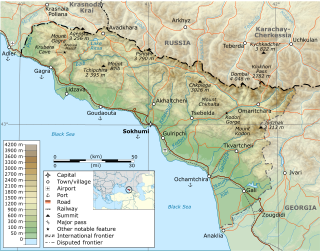
The War in Abkhazia was fought between Georgian government forces for the most part and Abkhaz separatist forces, Russian government armed forces and North Caucasian militants between 1992 and 1993. Ethnic Georgians who lived in Abkhazia fought largely on the side of Georgian government forces. Ethnic Armenians and Russians within Abkhazia's population largely supported the Abkhazians and many fought on their side. The separatists received support from thousands of North Caucasus and Cossack militants and from the Russian Federation forces stationed in and near Abkhazia.

The Abkhazian Armed Forces are the military forces of Abkhazia. The forces were officially created on 12 October 1992, after the outbreak of the 1992–1993 war with Georgia. The basis of the armed forces was formed by the ethnic Abkhaz National Guard. The Abkhaz military is primarily a ground force but includes small sea and air units. According to the authorities of the Republic of Abkhazia, the Abkhazian Land Forces are organised along the Swiss model – in time of peace they have personnel of 3,000 to 5,000 and in case of war further 40–50,000 reservists are called out. Georgia regards the Abkhaz armed forces as "unlawful military formations" and accuses Russia of supplying and training the Abkhaz troops.

Ochamchira District is a district of the partially recognised Abkhazia. Its capital is Ochamchire, the town by the same name. The district is smaller than the Ochamchire district in the de jure subdivision of Georgia, as some of its former territory is now part of Tkvarcheli District, formed by de facto Abkhaz authorities in 1995. The population of the Ochamchira district is 24,629 according to the 2003 census. Until the August 2008 Battle of the Kodori Valley, some mountainous parts of the district were still under Georgian control, as part of Upper Abkhazia.
Many inhabitants of Abkhazia are Orthodox Christians, With significant minorities adhering to Islam and the Abkhaz neopaganism, or the "Abkhazian traditional religion". The influence of this last has always remained strong and has been experiencing a revival through the 1990s and 2000s.
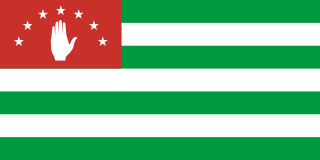
Abkhazia, officially the Republic of Abkhazia, is a partially recognised state in the South Caucasus, on the eastern coast of the Black Sea, at the intersection of Eastern Europe and Western Asia. It covers 8,665 square kilometres (3,346 sq mi) and has a population of around 245,000. Its capital and largest city is Sukhumi.
Kvemo Barghebi is a village in Gali Municipality of Georgia. As is the case in the rest of the district its population is almost exclusively Georgian.

Abkhazians of African descent or Afro-Abkhazians, also known as African Caucasians, were a small group of people of African descent in Abkhazia, who used to live mainly in the settlement Adzyubzha at the mouth of the Kodori River and the surrounding villages on the eastern coast of the Black Sea.
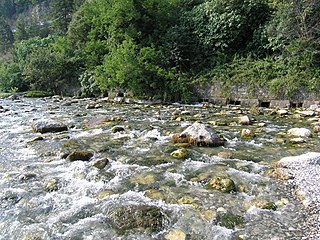
The Reprua is a river in the Gagra District of Abkhazia, Georgia. Only 18 m (59 ft) long, it is one of the shortest rivers in the world and is said to be one of the coldest rivers on the Black Sea coast.

Otapi is a village and municipality in Ochamchira District, Abkhazia, a partially-recognized state claimed by Georgia. The village lies on the Otapi River. Otapi is noted for its karst cave, Abrskil Cave, which is a tourist attraction in the area.
Abrskil Cave or Abrskila is a stalactite cave near Otapi village in Abkhazia, Georgia. It is named after the national hero of Abrskil — a parallel folk hero of the Greek Prometheus and Georgian Amiran — known as Abkhaz Prometheus. It is also called the Otap cave. Abrskila is more than 2 km in length out of which about 1.5 to 1.7 km is accessible for viewing. Its beauty and fame is compared favourably with another cave known as the New Athos Cave.
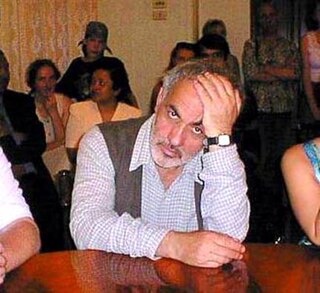
Daur Zantaria was a writer and journalist from Abkhazia, publishing both in Abkhaz and Russian languages.